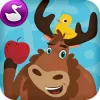Take a look inside 5 images
Moose Math by Duck Duck Moose
Pros: Multiple users and levels make for easy differentiation.
Cons: Kids may wish there were more parts of the town to build.
Bottom Line: An empowering tool for practicing early math skills through mini-games.
Since the challenge progresses as kids master a concept, you can use Moose Math to reach all levels of math learners in the classroom. Some kids can work on counting by 1s while others move on to 2s or 5s. Those who've mastered counting can move on to addition. Past concepts are still thrown into the practice to keep kids' skills sharp and recheck for understanding. Multiple user accounts on each device mean you can use it in a 1-to-1 classroom or a one-iPad classroom as well. Use the skills assessment report to get a snapshot of performance to help guide individualized instruction.
In Moose Math by Duck Duck Moose, five math mini-games come together in a little town that kids get to help build by choosing building facades and accessories to place in the town. Kids enter Moose Juice, the smoothie shop, to practice counting, addition, and subtraction. They go to the Pet Shop to play Pet Bingo, where they'll work more on counting, addition, and subtraction, or to play Paint Pet, where they'll match animals by counting dots. Then they can visit the Lost & Found store to sort shapes and colors and work on geometry, or to play dot-to-dot where they'll count by 1s, 2s, 5s, and 10s. As they complete each level, they'll get to add another feature to their town. Reports show which skills kids have mastered and which they need more work on.
The verbal cues are easy for kids to follow and can help kids with listening and following instructions. Kids work toward a goal -- building their town -- as they complete the mini-games. Kids are given choices at many points throughout play, so they're empowered to direct their learning.
The activities in Moose Math are aligned to the Common Core State Standards for kindergarten math and engage kids with activities tied loosely together by a story. Kids are empowered with the choices they have in what to add to their town. The mini-games get kids thinking mathematically, though some of the cute characters, namely the dust bunnies, seem an odd fit for the town. Kids are unlikely to give that a second thought, though.
Kids will learn to count using the objects (like fruit or dots or gems) as manipulatives. They'll also use objects as manipulatives to practice addition and subtraction. As kids work through the math problems, they physically add or take away objects to solve the problem, but they also see the equation written out, so they can associate the practice with the form of the equation. Kids also learn to count by 1s, 2s, 5s, and 10s. As they listen to follow the verbal instructions, kids will learn to pay attention to directions.
Adult controls on the screen keep kids out of the assessment reports and the gallery of other apps. Some of the hints and feedback could be more helpful, but most are well done. Overall, Moose Math is a fun way for kids to get some practice with early math skills.













